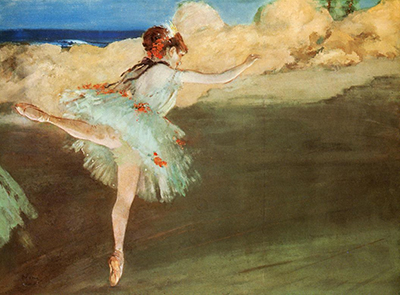Artist Edgar Degas incorporates a common element throughout his work of an off centre view point for the viewer.
Rather than showcasing his artwork from the front as most artists commonly do, he preferred to add more 3-D elements into his work with a slight side profile. This is incredibly captivating as it gives the paintings a more authentic feel as if you're a spectator analyzing what is occurring. This perspective has an outsider touch to it that lets the viewer peer into the scene, rather than feeling like a show is being put in. This touch is exactly what Edgar Degas attempted to manifest throughout his work. The artist was much more interested in showing us the truth within his work, rather than what everyone else sees.
One may argue that Degas adored this perspective throughout his work as it was the primary goal he worked to achieve. The Star showcases this exact element as it's slightly off centre and has a different feel to it. The viewer is able to witness a young ballerina balancing on her left tippy toe as she lifts her after leg towards her back. The woman gently lifts her chest highly above the ground and towards the sky. The ballerina also lifts her head towards the opposite end of the stage. The ballerina has light chestnut hair with glimpse of burgundy throughout. A white band covers her hair, falling into a red ribbon. Her hair is gently braided towards her back in ribbons and layers.
The ballerina is dressed in a lightly coloured mint costume that puffs out along the waist. The artist uses swift brush strokes going outwards to create the wonderful illusion of the skirt. The top of the corset gently hugs the woman as a small sleeve falls off of her shoulder. The womanÕs back is exposed as her corset falls in a low cut. The woman's skirt is accessorized in small bright ribbons throughout. These small orange pops of colour add dimension and life to the piece, especially since they're in a warm shade.
While initially looking into the piece, it seems as if the woman is performing outside. However, the beach setting is indeed just a stage. The background of the piece is painted in creamy shades of nude to imitate rock. Bright pops of blues are showcased near the back to illustrate the deep blue sea and sky. The wooden floor remains covered in a brown colour. Degas does not do much throughout the artwork to input additional characteristics. Instead, a deep brown colour is used to cover the ground of the stage. While Degas did not refer to himself as an impressionistic painter, it is evident through the piece that he indeed was. While he gently outlined the perimeter of the ballerina, the remainder of the painting is covered in fast brush strokes blended into one another.
Degas is known for not adoring to add significant detailing to the background of his work. Whether it was due to a lack of time, disinterest, or artistic vision, many of the backgrounds throughout his work remain plain. This is immensely different from the style of his contemporaries Pierre-Auguste Renoir and Claude Monet. These two prominent impressionistic artist added impeccable detailing onto the background of their work. However many art critics believe that Degas didn't care for the background of his work as it only brought more attention onto the focal point. Degas was a master at finding the exact elements to incorporate into his work to bring the viewerÕs perspective towards whatever he desired.




